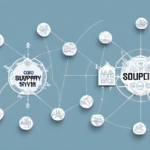Migrating Inventory to a New 3PL: Strategies for Success
Migrating inventory to a new third-party logistics provider (3PL) is a pivotal step for companies aiming to optimize their supply chain management processes. Although the process can be intricate and challenging, meticulous planning, selecting the appropriate 3PL partner, and ensuring a smooth transition can lead to significant success. This article delves into key strategies for migrating inventory to a new 3PL, enhanced with current data and insights.
Why Migrating Inventory to a New 3PL is Essential
Understanding the necessity of migrating inventory to a new 3PL provider is crucial before implementing any strategies. Companies may consider this transition for several compelling reasons:
- Scalability: As businesses grow, their inventory and supply chain needs evolve. A new 3PL provider might offer better scalability to accommodate increased demand and diverse inventory types.
- Technology Advancements: Modern 3PLs leverage advanced technologies such as AI and machine learning to enhance efficiency, accuracy, and visibility in supply chain operations.
- Improved Service Quality: Issues like poor communication, lack of transparency, and frequent errors with the current 3PL can prompt a search for a more reliable partner.
- Market Expansion: Expanding into new regions or markets may require a 3PL with localized expertise and resources to effectively manage inventory and distribution.
According to a Inbound Logistics report, the adoption of new 3PL services can lead to a 15-20% reduction in logistics costs, emphasizing the financial benefits of such migrations.
Key Factors to Consider Before Migrating Inventory
Prior to initiating the migration process, several critical factors must be evaluated to ensure a seamless transition:
- Cost: Assess the total costs involved, including transportation, technology integration, and labor. It's essential to perform a cost-benefit analysis to determine the financial viability of the migration.
- Timeframe: Understand the duration required for the migration and plan accordingly to minimize disruptions to the supply chain.
- Capacity and Capability: Ensure that the prospective 3PL has the infrastructure, technology, and expertise to handle your specific inventory needs.
- Security: Verify that the new 3PL employs robust security measures to protect inventory from theft, damage, or loss, including both physical and digital security protocols.
- Communication: Effective and transparent communication channels with the 3PL provider are vital for coordinating the migration and ongoing operations.
Research from the Supply Chain Digital highlights that clear communication can reduce migration-related issues by up to 30%.
Strategies for Successful Migration
1. Careful Planning and Preparation
Establish Clear Goals and Objectives: Define the reasons behind the migration, set measurable success criteria, and outline a realistic timeline. Clear objectives guide the entire migration process and help in measuring its effectiveness.
Conduct a Thorough Inventory Analysis: Analyze current inventory levels, types, locations, and any special handling requirements. This analysis informs the logistics and storage strategies of the new 3PL.
Develop a Detailed Project Plan: Create a comprehensive plan that includes timelines, task assignments, and contingency measures to address potential challenges.
Communicate with Stakeholders: Engage all relevant parties, including internal teams, the new 3PL, and external partners, to ensure alignment and smooth coordination throughout the migration process.
2. Choosing the Right 3PL Partner
Conduct Thorough Research: Evaluate potential 3PL providers based on their capabilities, technology stack, infrastructure, and industry reputation. Utilize resources like the American Shipper Network to identify top-rated 3PLs.
Develop Strong Relationships: Building a collaborative relationship with the 3PL ensures better communication and cooperation, which are essential for a successful migration.
Create an Effective Selection Process: Employ a rigorous selection process that includes setting clear evaluation criteria, conducting interviews, and performing site visits. Involving key stakeholders in this process ensures that all requirements are met.
3. Ensuring a Seamless Transition and Implementation
Effective Communication: Maintain open and transparent communication channels with the new 3PL and all stakeholders to facilitate coordination and address issues promptly.
Strong Project Management: Assign dedicated project managers to oversee the migration, ensuring that timelines are met and risks are managed effectively.
Ongoing Monitoring and Evaluation: Implement a framework for continuously monitoring key performance indicators (KPIs) and conducting regular reviews to assess the performance of the new 3PL.
Training and Development: Provide comprehensive training to employees on new systems and processes to ensure smooth adoption and minimize disruptions.
Continuous Improvement: Foster a culture of continuous improvement by regularly analyzing performance data and making necessary adjustments to optimize the supply chain operations.
Advantages of Migrating to a New 3PL
Switching to a new 3PL provider offers numerous benefits that can significantly enhance a company's supply chain management:
- Improved Efficiency: Leveraging advanced technologies and streamlined processes can lead to faster and more accurate order fulfillment.
- Greater Flexibility: A new 3PL can offer flexible solutions tailored to the specific needs of different markets and product lines.
- Reduced Risk: Enhanced security measures and robust disaster recovery plans minimize the risk of inventory loss or damage.
- Enhanced Customer Service: Improved communication, faster delivery times, and better tracking capabilities elevate the overall customer experience, fostering loyalty and satisfaction.
According to the McKinsey & Company, companies that utilize modern 3PL services experience a 25% increase in supply chain efficiency.
Common Challenges in Migrating Inventory and How to Overcome Them
Migrating inventory to a new 3PL provider is not without its challenges. However, with proactive strategies, these obstacles can be effectively managed:
1. Technology Integration
Integrating existing systems with the new 3PL's technology can be complex. To mitigate this, companies should:
- Conduct a thorough assessment of technology requirements before migration.
- Develop a detailed integration plan with timelines and responsible parties.
- Ensure that both internal IT teams and the 3PL's technical support collaborate closely during the integration process.
2. Cultural Differences
Differences in corporate cultures can lead to misunderstandings. To address this:
- Promote cultural sensitivity training for both internal teams and the 3PL provider.
- Establish clear communication protocols to bridge any cultural gaps.
3. Managing Disruptions
The migration process can disrupt normal operations. To minimize impact:
- Create a comprehensive contingency plan to handle potential disruptions.
- Maintain clear communication channels to swiftly address and resolve any issues that arise.
4. Cost Management
Unexpected costs can derail the migration. To manage expenses:
- Perform a detailed cost analysis before initiating the migration.
- Set a clear budget and monitor expenditures closely throughout the process.
5. Data Security
Protecting sensitive data during migration is paramount. To ensure data security:
- Implement robust encryption and secure data transfer protocols.
- Ensure that the new 3PL adheres to stringent data protection standards and regulations.
Key Performance Indicators (KPIs) to Monitor During Migration
Tracking the right KPIs is essential to assess the success of the migration. Key KPIs include:
- Inventory Accuracy: Ensures that the inventory data is precise, reducing errors in order fulfillment.
- Order Accuracy: Measures the correctness of orders processed by the new 3PL, impacting customer satisfaction.
- Cost Savings: Evaluates the financial benefits achieved through the migration, such as reduced logistics costs.
- Delivery Time: Monitors the speed of order deliveries, a critical factor in customer satisfaction.
- Customer Feedback: Gathers insights from customers regarding their experience with the new 3PL services.
According to Forbes, monitoring these KPIs can enhance supply chain performance by up to 20%.
Best Practices for Successful Migration
Adhering to established best practices can significantly increase the likelihood of a successful migration:
- Establish Clear Communication Channels: Maintain consistent and transparent communication with the 3PL provider and all stakeholders to ensure alignment and swift issue resolution.
- Involve Key Stakeholders: Engage employees, customers, and suppliers in the migration process to gather feedback and address their specific needs.
- Develop a Comprehensive Plan: Outline every aspect of the migration, including timelines, responsibilities, and risk management strategies, to ensure a structured and organized approach.
Implementing these best practices aligns with industry recommendations from sources like the Supply Chain Quarterly.
Cost Implications of Migrating Inventory to a New 3PL
Migrating to a new 3PL provider involves various costs, but the long-term benefits often justify the initial investment:
- Transportation Costs: Expenses related to moving inventory from the current 3PL to the new provider.
- Technology Integration: Costs associated with integrating IT systems and data migration.
- Labor Costs: Expenses for hiring additional staff or training existing employees to manage the new 3PL relationship.
However, companies can achieve significant long-term savings and efficiency gains. According to Gartner, companies that invest in efficient 3PL services can reduce their supply chain costs by up to 20% over time.
Conclusion: The Value of Migrating Inventory to a New 3PL
While migrating inventory to a new 3PL provider presents challenges, the strategic benefits make it a worthwhile endeavor for companies aiming to enhance their supply chain management. Through careful planning, selecting the right partner, and ensuring a smooth transition, businesses can achieve improved efficiency, greater flexibility, and reduced risks. The long-term advantages, including cost savings and enhanced customer satisfaction, underscore the importance of this strategic move in staying competitive in today's dynamic market.






















